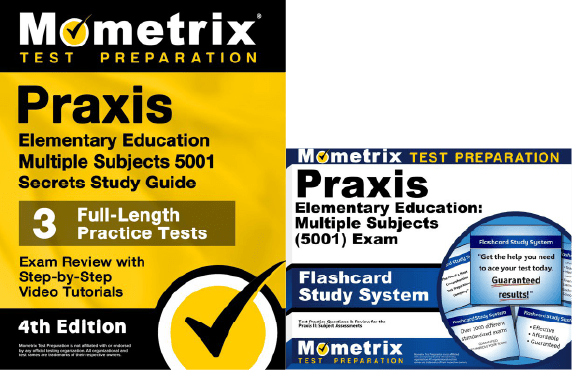If you need help studying for the Praxis Elementary Education: Multiple Subjects (5001) test or just want some more information about what the test is like, you’ve come to the right place!
Click below to take a free Praxis 5001 practice test!
What’s on the Exam?
First, let’s talk about the questions on the Praxis Elementary Education Multiple Subjects test. There are 245 questions in total, with most being selected-response and some being numeric-entry.
Selected-response questions require you to select the correct answer from a list of options. Multiple-choice questions are the most common example, but you may also see true-or-false questions and “matching” questions, which ask you to match terms or concepts with their definitions.
Numeric Entry
Numeric Entry questions involve entering numbers into answer boxes, rather than selecting an answer out of multiple choices.
The time limit for the full test is 4 hours and 35 minutes. There aren’t any scheduled breaks, but you’re free to take restroom breaks as needed!
Let’s take a closer look at the different sections of the test:
1. Reading and Language Arts
80 questions | 90 minutes
- The role of phonological awareness in literacy development
- The role of phonics and word analysis in literacy development
- The role of fluency in literacy development
- Using key ideas and details to comprehend text
- The affect of text structures on comprehension
- Point of view
- Comparing written, visual, and oral information
- The role of text complexity in reading development
Writing, Speaking, and Listening
- The characteristics of common types of writing
- The developmental stages of writing
- The characteristics of effective writing
- The importance of digital tools for producing and publishing writing
- Conventions of standard English grammar, usage, mechanics, and spelling
- Determining the meaning of words and phrases
- Characteristics of conversational, academic, and domain-specific language
- Characteristics of effective collaboration to promote comprehension
- Characteristics of engaging oral presentations
2. Mathematics
50 questions | 65 minutes
- The place value system
- Operations and properties of rational numbers
- Proportional relationships and percents
- Basic concepts of number theory
- Determining the reasonableness of results
Algebraic Thinking
- Evaluating and manipulating algebraic expressions, equations, and formulas
- The meanings of the solutions to linear equations and inequalities
- Recognizing and representing patterns
Geometry and Measurement, Data, Statistics, and Probability
- Classifying one-, two-, and three-dimensional figures
- Solving problems involving perimeter, area, surface area, and volume
- Components of the coordinate plane
- Graphing ordered pairs on the coordinate plane
- Solving problems involving measurement
- Basic statistical concepts
- Representing and interpreting data
- Interpreting probability
3. Social Studies
60 questions | 60 minutes
- European exploration and colonization in the US
- The American Revolution
- Major events and developments in US history
- 20th-century developments and transformations in the US
- Connections between causes and effects of events
- The nature, purpose, and forms of government
- Key documents and speeches
- The rights and responsibilities of citizenship in a democracy
Geography, Anthropology, and Sociology
- World and regional geography
- The interaction of physical and human systems
- The interactions of people with different cultural backgrounds with their environment, family, and communities
World History and Economics
- Major contributions of classical civilizations
- 20th-century developments and transformations in world history
- The role of cross-cultural comparisons in world history instruction
- Key terms and basic concepts of economics
- The effect of economics on population, resources, the government, and technology
- The government’s role in economics
4. Science
55 questions | 60 minutes
- The structure and processes of the Earth system
- Earth history
- Earth patterns, cycles, and change
Life Science
- The structure and function of living systems
- Reproduction and heredity
- Change over time in living things
- Regulation and behavior
- Unity and diversity of life, adaptation, and classification
- Personal health
Physical Science
- The physical and chemical properties and structure of matter
- Forces and motions
- Energy
- Interactions of energy and matter
How to Register
To register for the test, you’ll need to create an account on the ETS website. Once your account has been created, you can submit your application to take the test.
When you submit your registration, you will need to pay the $180 testing fee.
Praxis Scores
The Praxis 5001 test is scored using a scaled scoring method. Here’s how it works:
For every question you answer correctly, you get one point added to your raw score. At the end of the test, your final raw score will be converted to a scaled score. This scaled score will range somewhere between 100 and 200.
The reason your raw score is converted to a scaled score is because everyone that takes the test is given a slightly different set of questions. Since everyone has a different arrangement of questions, and because some questions are harder than others, converting your raw score to a scaled score ensures a more even playing field.
Receiving Your Score
When you receive your skill report, it will tell you how many questions you missed in each section and generally whether you passed or not.
Your scores will become available on your Praxis account on the score reporting date. When you get the score back depends on the testing date.
Online Praxis 5001 Prep Course
If you want to be fully prepared, Mometrix offers an online Praxis 5001 prep course. The course is designed to provide you with any and every resource you might want while studying. The Praxis 5001 course includes:
- Review Lessons Covering Every Topic
- 1,700+ Praxis 5001 Practice Questions
- More than 950 Digital Flashcards
- Over 380 Instructional Videos
- Money-back Guarantee
- Free Mobile Access
- and More!
The Praxis 5001 prep course is designed to help any learner get everything they need to prepare for their Praxis 5001 exam. Click below to check it out!
FAQs
How many questions are on the Praxis 5001 test?
The full test contains 245 questions.
What is the time limit for the Praxis 5001 test?
The test is timed at 4 hours and 35 minutes.
What is the passing score for the Praxis 5001 test?
The passing score changes from state to state.
How much does the Praxis 5001 test cost?
The testing fee is $180.



 Praxis Online Course
Praxis Online Course Praxis Study Guide
Praxis Study Guide Praxis Flashcards
Praxis Flashcards

